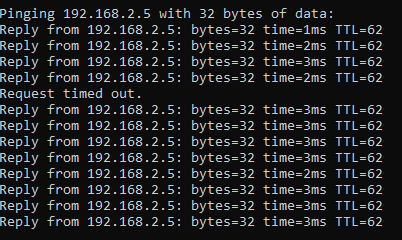OSPF Route Failover: Difference between revisions
mNo edit summary |
|||
| Line 27: | Line 27: | ||
===OSPF - General settings=== | ===OSPF - General settings=== | ||
---- | ---- | ||
[[File:OSPF Route failover general settings v1.png|border|class=tlt-border| | [[File:OSPF Route failover general settings v1.png|border|class=tlt-border|1075x1075px]] | ||
#Enable Service | #Enable Service | ||
#Enable vty | #Enable vty | ||
| Line 35: | Line 35: | ||
===OSPF Interface settings=== | ===OSPF Interface settings=== | ||
----[[File:OSPF Route failover interface settings v1.png|border|class=tlt-border| | ----[[File:OSPF Route failover interface settings v1.png|border|class=tlt-border|1091x1091px]] | ||
#Add 3 new interfaces for wan, WAN2 and WAN3 | #Add 3 new interfaces for wan, WAN2 and WAN3 | ||
#(Optional) Set interface priorities and custom dead times | #(Optional) Set interface priorities and custom dead times | ||
| Line 41: | Line 41: | ||
===OSPF Area settings=== | ===OSPF Area settings=== | ||
----[[File:OSPF Route failover area settings v1.png|border|class=tlt-border| | ----[[File:OSPF Route failover area settings v1.png|border|class=tlt-border|1089x1089px]] | ||
#Create 3 new instances with different Area codes and enable them: | #Create 3 new instances with different Area codes and enable them: | ||
##1005 | ##1005 | ||
| Line 48: | Line 48: | ||
===OSPF Networks settings=== | ===OSPF Networks settings=== | ||
----[[File:OSPF Route failover networks settings v1.png|border|class=tlt-border| | ----[[File:OSPF Route failover networks settings v1.png|border|class=tlt-border|1112x1112px]] | ||
#Add new instance, Network: 192.168.110.0/24; Assign first area | #Add new instance, Network: 192.168.110.0/24; Assign first area | ||
#Add new instance, Network: 10.0.110.0/24; Assign second area | #Add new instance, Network: 10.0.110.0/24; Assign second area | ||
Revision as of 16:40, 7 December 2022
Summary
The information in this page is updated in accordance with the RUTXXX_R_00_07_02 firmware version.
In this example we will setup redundant links using dynamic routing where 2 routers will be connected using multiple links directly – Main WAN and two Backup WANs in order to make sure LAN devices on each end would be available in case Main links fail.
Configuration Overview & Prerequisites
For this example, we will need two routers with 3 separate WAN interfaces. It can either be Wired links or Private Mobile networks. In this example we will use 3 wired links for the simplicity of testing. However, there can be other variations, such as 1 Wired link and 2 Mobile links.
Each WAN on both ends has to be in the same private network. In other words:
- RUT1 WAN1 interface must be able to reach RUT2 WAN1 interface;
- RUT1 WAN2 interface must be able to reach RUT2 WAN2 interface;
- RUT1 WAN3 interface must be able to reach RUT2 WAN3 interface.
Network Topology

Configuring Routers
We will not go too deep into basics. Assuming we already have VLANs set up to have three different links between routers according to the topology, we can jump straight into configuring dynamic routes using OSPF.
OSPF can be configured in WebUI, by navigating to Network → Routing → Dynamic Routing → OSPF.
Note: if dynamic routing is not available in WebUI, you can install an additional package by navigating to Services → Package Manager.
OSPF - General settings
- Enable Service
- Enable vty
- Set Router ID (Can be set to any number or IP address)
- Set "Generate a default" external route as Default
- Select Connected in "Redistribution options"
OSPF Interface settings
- Add 3 new interfaces for wan, WAN2 and WAN3
- (Optional) Set interface priorities and custom dead times
- Leave other settings as default
OSPF Area settings
- Create 3 new instances with different Area codes and enable them:
- 1005
- 1004
- 1003
OSPF Networks settings
- Add new instance, Network: 192.168.110.0/24; Assign first area
- Add new instance, Network: 10.0.110.0/24; Assign second area
- Add new instance, Network: 172.16.110.0/24; Assign third area
Second router
Second router should be configured analogously as the first router.
OSPF will now set routes dynamically depending on availability of the connected links, therefore if Main link fails, traffic will route through a backup link.
Testing Configuration
If everything was set up correctly, we should see routes to the second network through the main link in the routing table:
Let us simulate Main link failure by disconnecting the cable and see how that affects routes to the second network:
As we can see, dynamic routing automatically switched to the next available route.
Testing communication between LAN devices
Let us connect a LAN device to each of the routers and see if they can communicate with each other, for this example, we will connect laptop to the first router and another laptop to the second router:
- Laptop 1 IP: 192.168.1.220
- Laptop 2 IP: 192.168.2.5
Let us run a ping command from the first laptop to the second and disconnect the Main link cable midway through:
We can see that after a short delay, laptop on the second router continued communication, which means dynamic routes are being set correctly.






